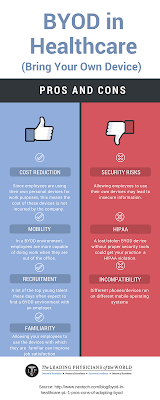BYOD in Healthcare
Practice of Bring Your Own Device
(BYOD) allows healthcare employees to bring and use their personal devices such
as tablets, smartphones and laptops into the work place. Their belief is that these
devices boost morale and increase efficiency and productivity levels.
With BYOD, healthcare providers can
use and access hospital information and applications on their personal devices.
However, healthcare facilities in the US and around the world continue to
struggle with whether staff should use their personal mobile devices at work.
While staff can use and access organization’s information and applications on
their own device, use of personal devices has brought a variety of security
threats for healthcare industries.
According to a recent study, 4 out of
5 doctors regularly use their personal mobile devices in their workplace for
health care purposes. It is with no doubt that these devices have been proven
to have a variety of benefits such as fast access to medical records. However, there
also exist some serious concerns and disadvantages associated with these
devices.
This article will examine BYOD
polices, BYOD use, and challenges associated with it.
BYOD Use
It is important to know that BYOD healthcare has created a number of efficiency and data security challenges for healthcare IT department. However, this does not discourage embracing wireless technology in healthcare organizations. Instead, the ongoing revolution in BYOD healthcare should be looked upon as an opportunity that gives providers and patients easy access to social media and also download the latest smartphone apps.
When done in the right way, BYOD can offer an opportunity to improve patient care. Major uses of BYOD in healthcare include:
·
Offering perfect patient care experience
·
Enhancing access to healthcare information by physicians
·
Enhancing collaboration, care coordination and communication in
healthcare
·
Enhancing patient, guest and physician satisfaction
·
Improving workflow processes.
According
to recent study, 71% of hospitals have allowed BYOD compared to 58% hospitals
in 2016. The study also shows that 63% doctors and 43% nurses use their
personal devices for work even if BYOD is prohibited in their hospitals. On the
other hand, 38% physicians and 59% nurses prefer using hospital-issued devices.
BYOD use by role
According
to a recent study conducted in 2017, healthcare providers use their own devices
if the hospital allows it or not. Below are statistics that covers BYOD use by
the role of the healthcare practitioner:
·
Transport
staff- 22%
·
Housekeeping
staff- 31%
·
Nurses-
43%
·
Administrators-
49%
·
Nurse
practitioners- 53%
·
Information
technology staff- 54%
·
Physicians
62%
BYOD challenges
With the rise of
BYOD in healthcare and residing of data on smartphones, desktops, tablets, USB
drivers and laptops, it means the process of protecting private information is
more complex. The process of keeping data safe while accessing healthcare
information from any device is complex and can pose dangers to healthcare IT.
Below are the most pressing BYOD challenges you should know:
- Data security
According to
recent study, 69% of healthcare practitioners use their devices for both
medical and personal communication. This brings a lot of pressure in the
healthcare industry because of end-user devices accessing hospital networks.
This means that there must be data insecurity if hospital data is not well
secured. Privacy of healthcare professionals is also undermined if personal
devices are used in the workplace. BYOD has been found to cause privacy risks
during personal communications.
- Infrastructure Wi-Fi coverage
Despite having
sensitive data in hospital databases, there is still insecure wireless networks
which cannot support multiple devices.
- Compliance with regulations
Complying with
regulations such as HITECH and HIPAA has become a great challenge when
implementing BYOD policies.
- Infrastructure cellular coverage
Hospital wireless
networks cannot support or control thousands of devices used in healthcare.
Tips for a Successful BYOD Healthcare
In
case you are planning to implement a BYOD solution, here is a list of 5main
components that can bring successful BYOD implementation into your organization
wireless network:
- Security for next generation
This
applies to new generation users who have new apps and security threats that can
pose a big risk to hospital wireless network. Use of traditional firewalls is
not applicable anymore. This means that nextgeneration security is a must. Next
generation security assimilates apps identification and control, intrusion
prevention and firewall enabling BYOD users have safe use of applications
without any threats. Next generation firewalls prevent data leakage, stop
threats and also conserve network performance.
- Secure wireless network
For
a successful BYOD support in hospitals, there should be a widespread wireless
access with suitable coverage and a capacity that is able to support millions
of devices. Hospitals should also ensure that their wireless networks are
secure against any outbound and inbound attacks. Since there is so much
sensitive data in hospitals, secure wireless network should be the top
priority.
- Role Based Access Control
Hospital
networks that support BYOD should be able to segment users based on who they
are and the type of device they are using. RBAC allows the user to assign a
role to the device on use depending on how it is authenticated. Once the device
role has been defined, access control rules can apply thereafter. Users can be
segmented into groups to allow their access based on their role. This simply
means that patients should not have access to same features physicians have
access to such as patient records.
- Unified performance management
With
all devices using a hospital wireless network, it is difficult to make sure the
bandwidth is optimized so that important things such as EMR are given priority
above other things such as YouTube and Netflix which are mostly used by
patients. Unified performance management has been seen to ease burden for
hospital IT staff as it combines application acceleration, bandwidth management
and WAN optimization into a single network for centralized management. Unified
performance management also makes sure all applications are running efficiently.
- Network access control





Comments
Post a Comment